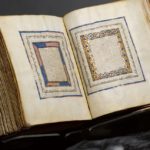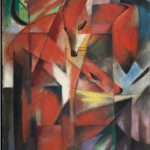
Penzance, UK.- In the late 19th Century, one of Britain’s foremost art movements centred around the tiny fishing village of Newlyn, on Cornwall’s far western shores. According to the Magazine of Art in 1898, “It was Birmingham that first discovered Newlyn”, and the acknowledged pioneer of the ‘Newlyn School’ was the Birmingham born and trained artist Walter Langley, who first visited in 1881. Langley was just one of many West Midlands artists who were to spend time in Newlyn, and this summer, Penlee House Gallery & Museum in Penzance is mounting the first ever survey of their contribution to this important artists’ colony. “Walter Langley and the Birmingham Boys” brings together a large selection of work by Langley with examples of works by some of his fellow Birmingham Newlyners.
 The show includes much-loved works from public collections across the UK, together with virtually unknown works from private collections. As with many of the exhibitions at Penlee House Gallery, the show will give a rare opportunity for paintings that have seldom been on public display to be seen ‘back home’ in Cornwall, in the context of the landscape and community which inspired them. The exhibition is on view at the museum until September 10th.
The show includes much-loved works from public collections across the UK, together with virtually unknown works from private collections. As with many of the exhibitions at Penlee House Gallery, the show will give a rare opportunity for paintings that have seldom been on public display to be seen ‘back home’ in Cornwall, in the context of the landscape and community which inspired them. The exhibition is on view at the museum until September 10th.
Walter Langley may not be a household name today, but in his day, he was greatly acclaimed. He was the only British artist of his generation invited to contribute a self-portrait to the Uffizi’s famous collection of portraits of great artists, where it hangs alongside those of Raphael, Rubens and Rembrandt. Proving that he appealed across the board, he was also singled out by Leo Tolstoy in his 1897 publication ‘What is Art?’ for producing works of art that were ‘beautiful and true’. Born in Birmingham in 1852, Langley initially trained at Birmingham School of Design before winning a scholarship to study at the South Kensington Schools, London. By 1879, he had become a professional artist and travelled to Newlyn in 1880 in search of artistic inspiration, which he found aplenty – a later arrival, Henry Scott Tuke, described it as “simply reeking with subjects”. Still known today as a vibrant fishing port, Newlyn at that time was full of picturesque charm, with the fishing and farming communities living their lives in the same way as their forebears, barely touched by the industrial revolution which had so radically changed Langley’s hometown.
1880 saw terrible storms along the Cornish coast, and many fishermen lost their lives. The worst incident involved the fishing lugger ‘Jane’ from the Newlyn’s neighbouring village of Mousehole, which was lost with all hands within sight of the village. As with the Penlee Lifeboat disaster in 1981, this not only devastated the local community, but also moved people across the country, and a national campaign to aid fishermen was launched. In 1881, Langley received a commission from a wealthy Birmingham patron – perhaps stirred by the ‘Jane’ disaster – to spend a whole year in Newlyn, documenting the difficult lives of the fisherfolk. Coming from a very poor, working class background himself, Langley was particularly touched by the hardship faced by the fishing community.
His paintings are filled with tales of tragedy and loss, painted with an astonishingly accomplished watercolour technique, capturing the full emotion of his subjects as well as their physicality. For much of the early 1880s, Langley divided his time between Birmingham and Newlyn, returning to exhibit his works at the Royal Birmingham Society of Artists and continuing to play a leading role in the city’s artistic life. Artist friends and acquaintances soon learned of Newlyn’s charms and fellow members of the Birmingham Art Circle (which Langley co-founded in 1880) started to make the trek to the far south west. Close friend Edwin Harris had accompanied Langley on one of his earliest Newlyn trips, and others including William Wainwright, William Banks Fortescue, William Breakspeare and Frank Richards followed on to become recognised members of the School.

Founded in 1839, the Penlee museum collections cover 6000 years of history in west Cornwall, from Penwith’s awe-inspiring archaeological sites to the area’s more recent social history. The recently refurbished social history gallery houses a wealth of artefacts covering the area’s fascinating and often quirky heritage. Built in 1865 as a gracious Victorian home, Penlee House has been converted to create a first class gallery and museum set within an attractive park. It specialises in showing the area’s unique, rich cultural heritage incorporating the historic collections of Penzance Town Council, Penwith District Council (now incorporated into Cornwall Council) and Newlyn Art Gallery. A programme of changing exhibitions celebrates the skill and craftsmanship of painting in west Cornwall in the late 19th and early 20th centuries, usually including the world famous ‘Newlyn School’ and Lamorna Group artists, such as Stanhope and Elizabeth Forbes, Walter Langley, Harold Harvey, Lamorna Birch and Laura Knight. Penlee House has a permanent collection of paintings which is actively being developed. Some of the best known works include “The Rain it Raineth Every Day” by Norman Garstin, “School is Out” by Elizabeth Forbes, “Among the Missing” by Walter Langley and “On Paul Hill” by Stanhope Forbes. Visit the museum’s website at … http://www.penleehouse.org.uk/







